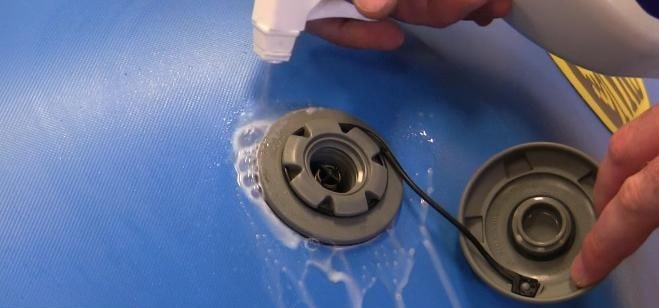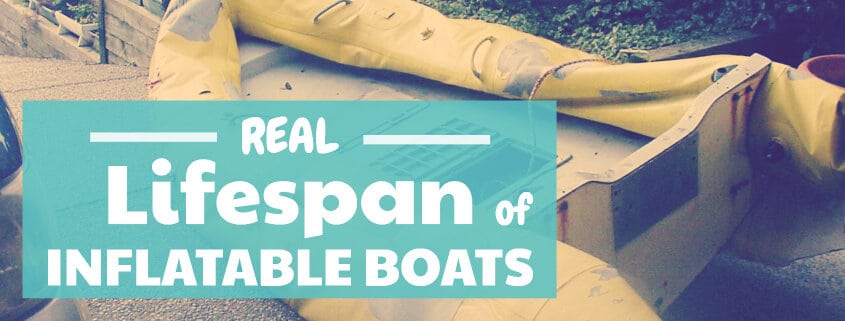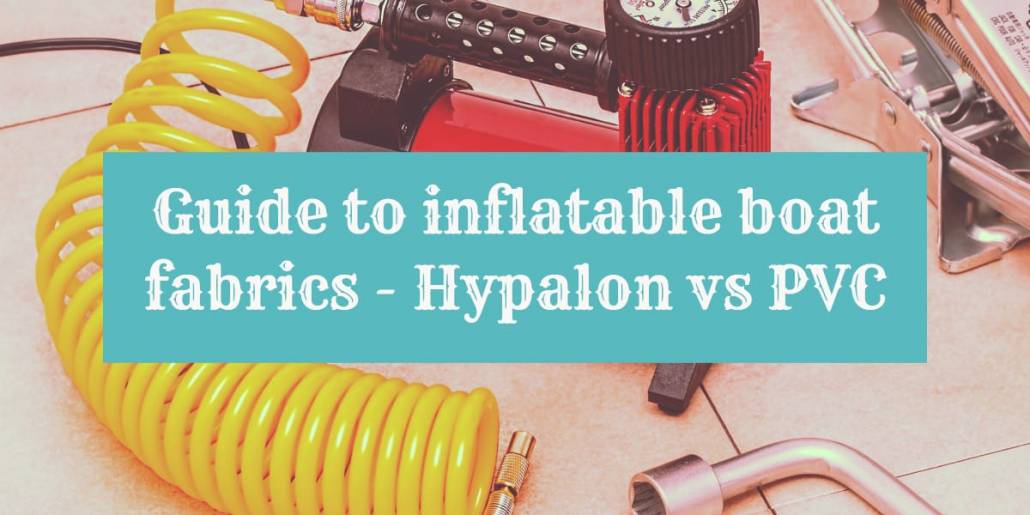Inflatable boats are durable, but like any other equipment, proper maintenance is a must to keep your dinghy in good condition.
However, accidents do happen.
Punctures and leaks are rare, but can be problematic. A slow air leak can be especially annoying, especially when you can’t find the source of the problem.
If your boat is losing air pressure – which is not caused by cold temperature – then, read this guide on how to fix punctures and slow air leaks in your inflatable boat.
A pro tip: Before you go out on the water, check your dinghy for punctures, leaks, or any other problems. Small problems can generally be fixed easily, but larger issues might need professional handling. Either way, it will be easier to locate the problem area in your home rather than on the water.
Now, that leads us to the first step:
Contents
Finding the leak
Let’s face it. Finding a puncture or leak is not easy. It’s like finding a needle in a haystack.
But, worry not.
You can easily find even the tiniest puncture with an easy hack:
Soapy water solution
Any brand of soap or detergent will do.
First off, inflate your boat in a very quiet place and try to listen for the leak. If you hear any hissing and can narrow the area down, you’re golden. Use a spray bottle filled with your soapy water to identify the exact source of the leak.
If you have no idea where the leak is coming from, spread the solution over the boat with a hand towel or large sponge and look for bubbles. Escaping air would lead to the formation of bubbles over time; if you see bubbles forming in an area, that’s where your leak is coming from.
Don’t stop after finding one!
Chances are there are other punctures or leaks in your inflatable boat. It’s better to check and fix all of them at the same time.
If you can’t find any punctures in the material of the boat, the air leak might be caused by poorly fitted valves. To check, simply apply soapy water around the valve and check for bubbles.
Poorly fitted valves are actually the number one cause of slow leaks.

Now that you’ve found the leak, what’s the next step?
How to fix a leaking air valve
If you suspect that the valve is the source of the leak, verify this by using a soapy water solution.
Inflate the dinghy, and then apply the soapy mixture around the valve and on its cover cap. Check for bubbles.
Air might leak around the valve perimeter, cover cap perimeter or even the area around the entrance of the valve housing. To determine how to fix the problem, you must know which of these three parts the leak is coming from.
If the leak is coming from around the valve perimeter, there is a chance that the valve is poorly-fitted. In this case, you should remove the valve and clean the area where it is inserted, then put the valve back in place and tighten it.
For leaks that are coming from the cover cap perimeter or from the area around the entrance of the valve housing, you can quickly seal it by applying glue or sealant around the valve housing perimeter. You can also put a drop of glue inside the opening. Household silicone sealant may also be applied instead of glue.
It’s also possible that the rubber seal ring of your inflatable boat will accumulate dirt and debris over time. There’s also a possibility of it getting worn out. This will also result to air slowly leaking from the valve perimeter.
Also, the valve itself may be the culprit.
Unscrew the valve and clean it thoroughly.
If your valve rubber seal ring accumulated dirt and debris, you will need to pump air into the open valve with an air pump to remove them. But, keep the hose away from the valve’s unlocked pushpin.
Putting a little bit of acetone can help clean dirt around the valve housing perimeter. Just remember to leave the valve open for the acetone to dry.
If the rubber seal ring has been worn out, you will need to replace it.
How to fix a punctured inflatable boat
It is important to determine how big the leak is to know how to fix it. Refer to the guide below.
Punctures less than 1/8″ in size
Punctures less than 1/8” in size can be repaired without a patch. You will only need either glue or a sealant.
Here is a step-by-step guide to fixing small punctures less than 1/8” in size:
- Deflate your dinghy and clean the area to be repaired.
- Apply a drop of glue or sealant to cover the puncture.
Note that the surface to be repaired should be dry before you apply the glue or sealant. Also, remember to use the appropriate glue that suits the material of your inflatable boat.
- Let it dry for 30 minutes.
- Inflate the repaired chamber but only 3/4 full.
- Apply a larger drop to coat it better.
- Let it dry for at least 24 hours.
Lots of small punctures
If you identify many small punctures, it might be more efficient to use a sealant.
Inflatable boat sealant is basically a chemical which you put into your air valve. The sealant finds its way to the punctures, and seals them.
Read this article on how to use SIB sealant.
Punctures that are 1/8″ to 4″ in size
Punctures that are as big as 1/8′ or bigger will need patchwork.
Fret not! Your inflatable boat usually comes with a repair kit, but if not, this is the one I use.
Below is a step-by-step guide on how to patch up a leak.

- Mark the area to be repaired.
- Cut a piece of the patch repair material by approximately 2” off the edges to overlap the damaged area.
- Apply a thin layer of glue on the underside of the patch. Use a brush.
- Wait 10 minutes for the glue to set.
- Apply another layer of glue on the underside of the patch again. Use a brush.
- Apply a thin layer of glue around the damaged area as well. Use a brush.
- Wait for 3 minutes for the glue to set.
- Firmly put the patch on the damaged area.
- Wait for 10 minutes.
- Then, inflate the chamber slightly – to avoid it from getting glued together
- Apply a 3 to 5 lbs weight on the repaired area for 24 hours.
- Put another layer of glue around the edges of the patch to completely seal it.
- Let it dry for at least 6 hours.
Here is a nice video on the process as well.
A pro tip: It is recommended to do repairs in dry weather. Humidity can cause a decrease in your glue bond.
What if you cannot find the air leak, but you know there is one?
Sometimes you just cannot locate the puncture despite trying and trying again. The boat loses air slowly, but you just can’t find the leak.
First of all, check everything again. Yes, for the 3rd time. Check all of the valves, rub your boat with dishwashing liquid, etc.
If you still can’t find the puncture, it will probably be a super small leak or a number of smaller leaks. This is when I would use a sealant to fix the boat.





![[Guide] Inflatable Sports Boat Registration in All US States (2024 Update)](https://pumpupboats.com/wp-content/uploads/2019/02/A-guide-on-inflatable-sports-boat-registration-in-all-US-states.jpg)
I have about a 2 inch long “slice” (tear with clean edges) on the drop stitch flood of a Saturn 330. There also seems to be some repair work around the valve seam near the tear (a large amount of glue) I bought the boat used and do not have a repair kit. Any suggestions on a fix or patch kit recommendations? When I try to patch, will.I need to try to remove the “old” glue?
That’s a pretty long tear. The repair process on high pressure floors is the same, but I’m not sure it will hold with a 2″ tear.
Here is a video:
https://www.youtube.com/watch?v=pSgi-F8Zxp4
I have a small inflatable with 3 piece HR valves. I need to replace the valve plunger and have purchased a new valve, but I cannot get the old valve apart. I have a valve removal wrench but the two parts are stuck together. Is there a hack for getting the two valve parts apart? Heat, or soaking in soap or solvent or?? Thanks
You need to deflate the boat and grab the backing of the valve through the deflated material. Once you have a good hold on it with one hand, use your valve tool to screw it out.
I had a stuck valve once, and I actually broke the plastic valve tool when trying to unscrew it. I had to get a metal valve tool, and that did the job nicely.
To find a small leak in an air bottom floor. Fill the dinghy with water until the floor is covered, look for leaks, which will be creating bubbles. Easier than using soap and water.
I have a very old Boston Whaler BWC3J inflatable boat with a 2″ diameter hole in one of the outer chambers. Can you tell me if it is PVC or Hypalon? Which type of repair kit should I use?
Hi Allen, I am not familiar with your boat, but PVC is easy to tell apart from Hypalon.
Read this article and you’ll find out how:
https://pumpupboats.com/inflatable-boat-fabrics-hypalon-pvc/
Hi there, I just recieved a dinghy and it had a substantial hole on the seam. We have repaired that. However still looking for others. 😞
It’s a brigs 11.3 foot hard bottom. My question for you is what is the best sealer for inside the air chambers?
I’m going to try this today.
Thank you
Hi Ally, I have an article on sealants here:
https://pumpupboats.com/inflatable-boat-sealant-usage-guide/
Hope it works for you, let me know how it turns out, please!
I have a Caribe RIB with 3 inflatable tubes which I have assumed are not connected. For the first time, a few weeks ago all 3 started leaking air, and seemingly to the same degree. Thoughts?
The air chambers are definitely not connected. If the weather gets colder, the air pressure inside all of the tubes will decrease. This might seem like they are losing air at the same time, but of course, it stops after a while.
If the chambers continue deflating, go through the steps on this page to find the problem.